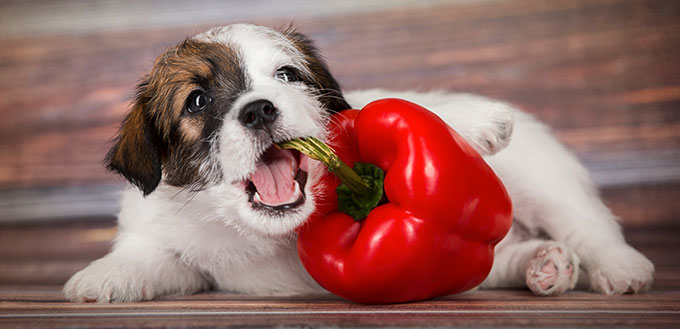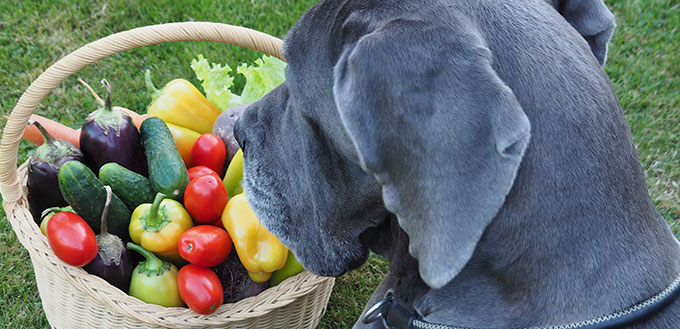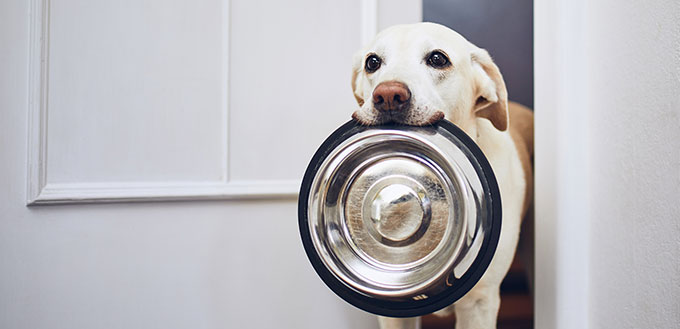About to sit down to a lunch of salad greens topped with sweet, red bell pepper slices? Your dog is nearby, ignoring their dog food in favor of staring at your plate, and we’re sure you’re wondering whether or not it’s safe for you to slip a piece of bell pepper into your dog’s maw.
Are Peppers Good for Dogs?
Some peppers are absolutely fine for dogs to eat, but not all variants of the pepper vegetable can be consumed by dogs without causing some major issues.
As a controlled part of your dog’s diet, feeding them peppers that they can eat is no different from treating your dog some carrot or watermelon. There are benefits in a lot of the vegetables and fruit that we humans eat day to day, and our dogs can benefit from them, too.
Peppers are low in fat and have a good water content – which can help hydrate your dog. Obviously, a pepper can’t replace (and shouldn’t replace) fresh water, but it can be a hydrating treat on a hot day. Much like watermelon, a slice or cube of pepper can give your pup a little more pep in their step. They’re nutritionally beneficial for your dog’s body, and an excellent addition to a pet’s diet.

What Kind of Peppers Can Your Pup Eat?
Dogs can eat any color of bell pepper that you happen to pick up during your weekly food shopping trip. Bell peppers, eaten in moderation and properly prepared, will not harm your dog. They can be added to your dog’s diet alongside their regular dog food and given as a treat.
Most other variations of the pepper vegetable are not suitable for dogs to eat, so it’s best to only feed them varieties of bell pepper. You can feed your dog any color of bell pepper, though they may prefer the sweetness of red bell peppers the most.
Feeding Your Dog Bell Peppers
As we’ve mentioned, feeding your dog bell peppers is completely fine. Dogs eat bell peppers without any issues, as long as their owner prepares the bell peppers properly.
Like any other fruits or vegetables that you would feed your dog, be sure to remove any of the bell pepper seeds before letting your pup chow down on these tasty treats. They can eat bell peppers, but there are parts of the bell pepper that you should not feed your dog – and seeds are just one of these parts. When in doubt, only ever feed your dog the main part of the vegetable.
Never, under any circumstance, feed your dog bell peppers that have been cooked with onion or garlic. If you haven’t prepared the bell peppers yourself, assume they have been cooked with something, and don’t let your dog eat them. Both onion and garlic are toxic to dogs and will earn you and your pup a trip to the nearest emergency vet.
Frying and seasoning bell peppers can also be an issue. We know that many recipes that use sweet peppers or green peppers will want them cooked in a particular way, and that’s absolutely fine for you, but not for your dog. If you want to include your dog in your dinner plans, why not cook a few green peppers separately or have some sweet peppers on the side that they can eat while you cook?
Feeding Your Dog Red Peppers
The red bell pepper is probably the most common pepper used in recipes. They’re cheap, you can find them in all farmer’s markets and food shops. Cooking shows often show chefs using red bell peppers rather than any other color… These sweet peppers are perfect for your dog, but they aren’t the only variant of pepper out there that has a red color. When grocery shopping, be sure that you’re reading labels and buying peppers that are clearly labeled as bell peppers and not other variants. Though you’ll find your dog eats other peppers, they’re just eating what you’ve put in front of them and don’t know the harm it will later cause them.
Avoid Spicy Peppers
Spicy pepper varieties are not suitable for dogs to eat. Your dog won’t get any of the benefits of bell peppers by eating spicy peppers and not just because they’re the wrong type of pepper. Spicy food is not suitable to feed your dog. Hot pepper variants and chili peppers can seriously damage your dog’s gastrointestinal tract, burn their mouth, and cause plenty of other health issues.
Think about the person in your family or friend group who can’t tolerate spice at all. Spice to them is putting a little black pepper on their food and ordering a korma curry. Their spice tolerance is the same as your dogs: Non-existent. It would be cruel to feed your dog something spicy.
Can Dogs Eat Chili?
Dogs cannot eat any form of chili and there’s some science behind the reason why. Chilli recipes call for all kinds of peppers, including jalapenos, which will be more than your dog can tolerate without getting sick. Beyond the fact that you shouldn’t give your dog spicy peppers, a chili dish often contains capsaicin, too.
Capsaicin is an active ingredient in many spicy pepper variants. It is the thing that causes us to feel that hot, sometimes burning feeling when we eat a spicy pepper. For a dish meant to be human food, many of us enjoy this sensation. That actually makes humans quite strange when it comes to the animal kingdom because other mammals – like dogs – experience capsaicin as an irritant. The irritation is there to stop them from eating the plant that has grown food that won’t be good for them. Capsaicin will cause gastrointestinal upset, discomfort, and other side effects when consumed by dogs.
Even a mild chili dish has the potential to cause stomach issues for your pup. Dogs have sensitive stomachs that can’t handle a lot of the same food that humans eat. As a dog owner, it is your duty to ensure that your dog retains a healthy immune system and digestive system. That means keeping your pup well away from hot peppers and any other food that could give them an upset stomach.
If your dog has eaten any chili that had an irritant in it, you may notice that they retch, cough, are sick, or that they try to drink a lot of water. Keep an eye on your pup if they begin to drink excessive amounts of water because this can become dangerous if they bloat too badly.
Check out our review of the Best Dog Food for Sensitive Stomach.
Can Dogs Eat Black Pepper?
Peppercorn, also know as black pepper, is a type of seasoning that is often used on human food alongside salt. Though dogs can consume peppercorn without any toxic side effects, eating too much of it can upset their stomach in the same way that spicy food can. Small dogs, especially, are at risk of gastrointestinal upset by eating too much black pepper.
Very small quantities of peppercorn are fine for your dog to eat, so don’t be concerned if they take a bit of food off your plate that you’ve cracked pepper onto. You shouldn’t go out of your way to spice up your dog’s diet with black pepper, it’s an unnecessary addition to their everyday food, and dog stomachs are very sensitive to the seasonings that we humans use.

How Peppers Could Benefit Your Dog
Peppers, like many other vegetables, have excellent health benefits. They’re a source of beta carotene and vitamin C, both of which are great additions to your dog’s diet. When beta carotene is digested, it turns into vitamin A, which can assist your dog by promoting a shiny, healthy coat and good eye health.
Vitamin C, on the other hand, is used as an antioxidant. This is another important part of your dog’s diet because it can help reduce any inflammation in their body, while also riding the body of any harmful free radicals (unstable atoms in the body that can damage cells, make your pup sick, and age them).
Though any bell peppers are fine to feed your pup, red bell peppers are considered to be the best ones to use as a refreshing treat for your dog. This is because they contain the highest amount of vitamins in any of the bell pepper variations.
Additional Health Benefits of Peppers
As well as containing vitamins A, B6, C, and E, bell peppers contain lutein. Like vitamin C, lutein is an antioxidant that can benefit your dog’s body in various ways. The major benefit of lutein is that it can boost retinal response in dogs, aiding their eyesight.
Bell peppers aren’t the only source of lutein, and it’s considered a safe chemical to allow your dog to consume. You can also find lutein in leafy green vegetables, like spinach.
What are the Potential Risks of Feeding Your Dog Peppers?
Like any human food that you would feed your pup, it’s best to give them bell peppers in moderation. Not all dogs can tolerate bell peppers, just like not all humans can tolerate every human food that you can buy. If you know that your dog usually has a sensitive stomach, try feeding them a very small, cooked piece of red bell pepper before giving them any more in the future. Cooked bell pepper is easier on the stomach, and red bell pepper is sweeter than the other kinds.
Provided that your pup is able to digest that small piece of red bell pepper without any issues, they should be fine to continue eating it. However, if you notice that your dog has any adverse reactions – such as digestive distress – add bell pepper to your dog’s “do not feed” list.
The Parts of Bell Pepper Your Dog Can Eat
It is only safe for your dog to consume the main part of a bell pepper. Avoid feeding your dog the seeds, vine, leaves, stem, or roots of a bell pepper plant.
Seeds can cause intestinal blockages, no matter what fruit or vegetable they come from. You’ll find that any guide to feeding your dog a piece of fruit or a slice of vegetable will tell you to remove any and all seeds before you do. We won’t be changing that narrative here. Be sure to cut out all of the seeds before you feed your dog any bell pepper pieces.
The rest of the plant can also cause problems of its own and are best to be completely avoided.
How to Prepare Peppers for Your Dog
Raw bell peppers are fine but your dog may find them a little difficult to digest. To combat this, there are different ways you can prepare bell peppers for your dog to eat.
- Pureed bell peppers served in a small dish or over your dog’s regular dog food
- Roasted red bell peppers without any oil or seasoning
- Boiled bell peppers cut into small pieces
- Small cuts of raw bell pepper that are easier for your dog to chew and digest than large pieces
Easy DIY Pepper Dog Treats
The quickest way to prepare a bell pepper treat for your dog would be to boil the vegetable and puree them into a thick liquid. You can then add this to the top of your dog’s food, and it can be quite refreshing for your pup. You don’t want to add anything else to the puree because adding too much fat or the wrong ingredients to your dog’s food can hurt them. Best to keep their food simple!
With their nutritional value, you don’t need to get clever with pepper recipes for your dog. But you could also take that puree and freeze it into cubes for your dog to enjoy in the summertime. You’ll always have some pepper at the ready on a hot day.
Check out some of our dog treats guides, such as Gourmet Dog Treats and Vegan Dog Treats.

FAQs:
Q: How often and how many peppers can dogs eat?
A: A large dog will always be able to handle eating more of a fruit or vegetable than a small dog, but you should still stick to small amounts of any human food that you feed your pup. A slice or two of bell pepper is plenty and can be a good treat every two or three days.
Q: Can dogs be allergic to peppers?
A: As with all food, there is a possibility that your dog could be allergic or intolerant to peppers, which is why we’ve suggested that you start your dog out with a very small amount of bell pepper to see how they handle it. If your dog starts breathing strangely, coughing, or throwing up, take them to your closest veterinarian.
Take a look at our article on the Best Dog Food for Dogs with Allergies.







